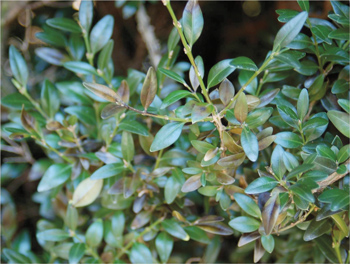 A virulent fungal blight affecting boxwood is the newest cause for concern for homeowners, gardeners, landscapers, and landscape designers.
A virulent fungal blight affecting boxwood is the newest cause for concern for homeowners, gardeners, landscapers, and landscape designers.
By Mary-Liz Campbell
 A virulent fungal blight affecting boxwood is the newest cause for concern for homeowners, gardeners, landscapers, and landscape designers. The evergreen shrub boxwood (buxus sempervirens and other cultivars) is a staple of many foundation plantings and is used by designers to define the walls of “garden rooms”. It’s also one of the few evergreen shrubs that is deer-resistant. In addition, the ground cover pachysandra (also deer-resistant) has been identified as a host for the blight.
A virulent fungal blight affecting boxwood is the newest cause for concern for homeowners, gardeners, landscapers, and landscape designers. The evergreen shrub boxwood (buxus sempervirens and other cultivars) is a staple of many foundation plantings and is used by designers to define the walls of “garden rooms”. It’s also one of the few evergreen shrubs that is deer-resistant. In addition, the ground cover pachysandra (also deer-resistant) has been identified as a host for the blight.
The disease was discovered in the mid 1990s in Australia and the United Kingdom. It is not known how the pathogen entered the U.S. Boxwood has been affected in the Mid-Atlantic states and New England, including New York and Connecticut. The fungus is believed to travel with or through water. It is a sticky substance that can cling to clippers and clothes.
The fungus (cylindrocladium pseudonaviculatum) affects all aboveground parts of the plant, not the roots. Light or dark brown spots or lesions appear on the leaves. They grow together turning the whole leaf brown. Infected plants will rapidly defoliate within a week. Plants other than boxwood are not affected.
How to deal with boxwood blight?
Fungicides cannot cure the blight, but may work in preventing infection.
Don’t plant boxwood too tightly.
Reduce moisture by using drip irrigation instead of overhead watering.
Sanitation is important – wipe all clippers with an organic soap.
Dispose of all affected plants in plastic bags to prevent it from spreading.
Plant nurseries and garden centers are being inspected regularly, and quarantined if the blight is found.















